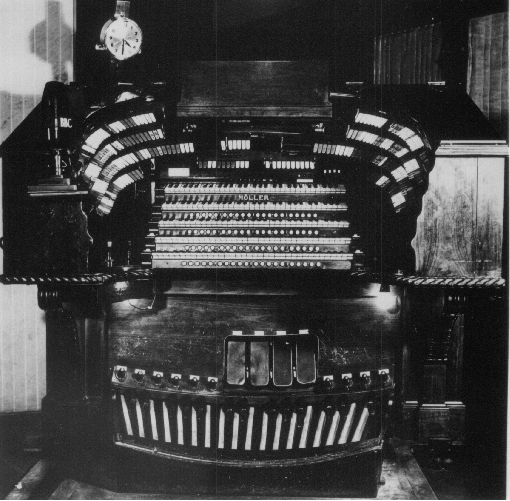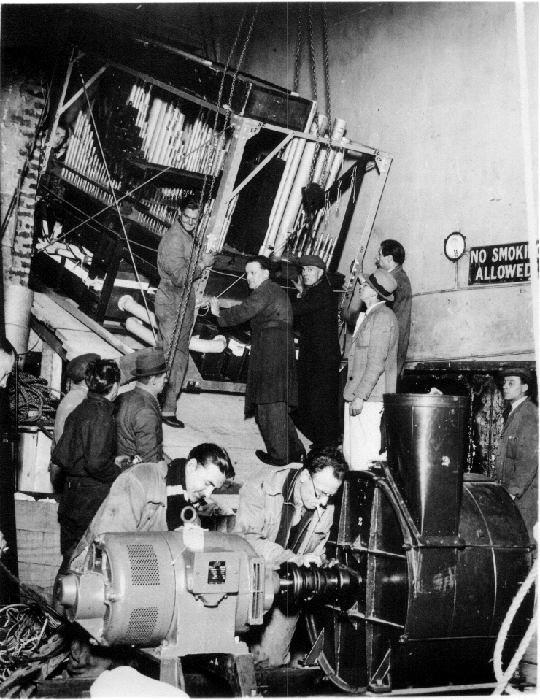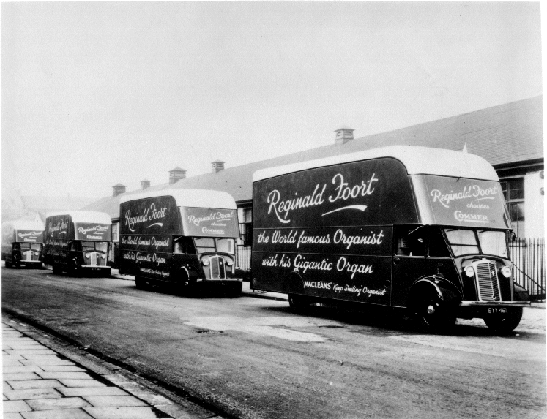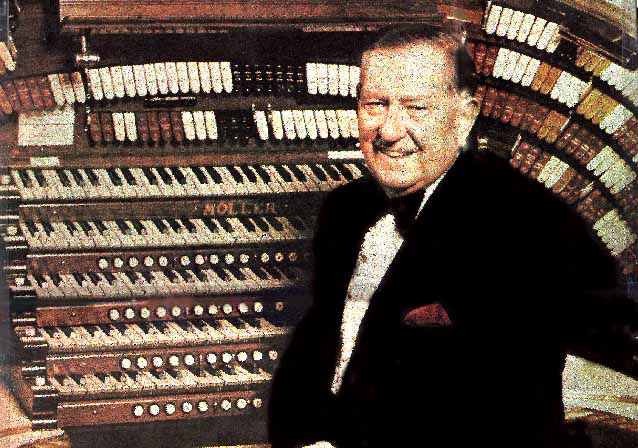

During the thirties the theatre organ was almost completely gone
throughout the US due to the advent of sound movies. The organs were still
heard in large theatres which had stage shows and on radio programs in
studios which were pipe organ equipped, but largely fell to disuse in most
other instances. This was not true across the Atlantic in Great Britain
where theatre organs were still immensely popular. The BBC (British Broadcasting
Corporation) was broadcasting organ programs from theatres, but due to
the lateness of the hours that they could use the organs the BBC decided
to equip a radio studio with a theatre organ and had Compton build a theatre
organ for them. It was considered to be one of the finest theatre organs
ever built in Britain and was immensely popular on the airwaves. The BBC
organ went on the air in October 1936 and comprised four manuals with 23
units and included a grand piano playable from the console and a complete
range of tonal and non-tonal percussions. Reginald Foort was a staff organist
at the BBC and was extremely popular with British audiences He was allowed
to take two outside engagements a month and found that they were always
sold out performances. Vaudeville was extremely popular in the years prior
to WW2 and Foort got the idea that an organ performance would be a popular
addition to the vaudeville bill. The theatres were always run along the
same lines with two shows nightly except on Sunday when all the theatres
were dark. The shows were normally changed weekly. Most theatres were not
organ equipped so he surmised it would be necessary to have an instrument
which could be taken down after the last show on Saturday night, transported
to the next theatre, usually within a 100 miles and set up ready for the
first show Monday evening. Foort describes the Traveling Organ in his book
"The Cinema Organ" and following is excerpted from his narrative.. He decided
that an organ of at least four manuals and 16 ranks would be the minimum
requirement for his instrument. He set about designing the organ and ultimately
designed an 5 manual 27 rank instrument. For various reasons the British
organ builders would not or could not build what Foort wanted. He found
the M. P. Moller of Hagerstown, Maryland was willing to build an organ
to Foort's specification with the understanding that he not complain if
he didn't like what he got. Foort's idea was to build an organ on a grand
scale which would be impressive when compared to other theatre organs that
may be installed in nearby theatres. The organ had the following ranks:
Tuba Mirabilis, Tuba Horn, Brass Trumpet, Chorus Trumpet English Post Horn,
Diaphonic Diapason, English Diapason, Tibia Clausa I, Tibia Clausa II,
Tibia Clausa III, Doppel Tibia, Vox Humana I, Vox Humana II, Clarinet,
Krumet, Orchestra Oboe, Saxophone, Musette, Viol d' Orchestra, VDO Celeste,
Gamba, Gamba Celeste, Orchestra Strings (2 ranks), Muted Strings (2 ranks)
and Concert Flute. Five ranks were carried down to 16' pitch to form a
magnificent Pedal Organ, Tuba Mirabilis,
Chorus Trumpet, Diaphonic Diapason, Concert Flute and Gamba. (Moller
had insisted that the organ needed a pedal string and provided the Gamba
at no extra charge...unfortunately the Gamba metal was too soft to endure
over the road trips and was put into storage) The Tibia I was supposed
to be the biggest ever built. That stop and the reeds were on 15" wind.
The organ arrived in London in 1938 and immediately started touring
the vaudeville circuit. Foort resigned from the BBC to tour with the organ.
They had engaged a staff of fifteen and purchased four 30 ft road trucks
to transport the organ. Altogether the organ weighed 30 tons and the staff
to handle it consisted of four truck drivers (who rapidly became expert
organ builders) 3 real organ builders, 2 electricians, 2 stage riggers,
1 young messenger, a manager in charge of everything whose wife acted as
secretary and an advance publicity man.


"Regarding Reggie Foort's Traveling Organ, before the war, it was stored in four or five pantechnicons, (large trucks to you residents of North America), and they were garaged in a large mover's garage next door to where I lived as a boy. Many the time I would wander in when they were either going or coming, so the truckers and the building crew got to know me, and one day I was invited to go along with them to Harringay Arena where the organ was going to be set up for a Reggie Foort concert. I remember it as being quite an organ, (much bigger than the one in the church where I was a choirboy), and although at the age of 12 or 13, I wasn't allowed to actually try to play it, I was allowed to sit at the console and marvel at all the tabs, pistons and foot controls. I was even allowed to stay for the concert, and was introduced to Reggie Foort as his youngest "techie". I never saw it assembled again, although I often heard it on the wireless when the BBC had it for organ recitals, with Quintin Maclean playing it. After the war it went to Holland which is where John Vanderlee would have heard it. "
Unfortunately the timing of this project was not good. The war in Europe cut short the travel of this unique organ and after a successful 10 months it came to an abrupt halt when half of the trucks were taken for the transport of war materials. Another unfortunate result of the war was he loss of the BBC theatre organ in one of the early bombing raids. Foort offered the BBC the use of the Moller and it was installed in a unused Methodist Chapel the BBC took for an interim broadcast facility. The Moller found a home in Jubilee Chapel which lasted long past the end of WW2 and changes on the entertainment scene after the war made it apparent the resumption of the traveling organ was no longer practical. Foort sold the organ to the BBC after the war and it remained in the Jubilee Chapel nearly eighteen years.
These comments from Stanley King
"The Foort
Moller was the BBC Theatre Organ after the war and was housed in a disused
Methodist Chapel in East Road Hoxton North London England. This organ was
broadcast every morning at 10.am
( known
as the "10 o'clock bash!") on th BBC. The organist in charge of all this
was Sandy McPhearson who at that time was the staff organist of the BBC.
I was happy to be one of the organists who broadcast this instrument."
When the BBC decided the Moller no longer fit into their broadcasting scheme the organ was sold to Netherlands Radio VARA and installed in a studio in Hilversum. There is little information about this period of the Moller's history and it is said that it was very rarely heard on broadcasts.
These comments from Aida van de Brake:
"The organ
appears to have been sold in the 60s to the NRU, Dutch Radio Union, which
later was called NOS, Dutch Broadcasting Association, the company that
encompassed all the Dutch public (not commercial) national TV- and radio
stations (VARA, TROS, AVRO, VPRO, etc., etc.). I gather it never went back
to England."
In the 1970's the Moller was given a new chance to be heard when San Diego business man Preston "Sandy" Fleet purchased the organ from the Dutch radio station for his pizza restaurant. The Moller made the trip back across the Atlantic, first returning to the Moller factory in Hagerstown for repairs and updating before installation in it's new home in the "Organ Power Pizza" in Pacific Beach, California, just outside San Diego. The organ remained basically the same as originally designed by Foort except for the replacement of the Moller Tibia I by the WurliTzer Solo Tibia from the Brooklyn Fox and the addition of a Trumpet enchamade which brought the organ up to 28 ranks.
These comments from Wendell Shoberg :
"When Sandy Fleet bought the Foort Organ, it was decided the the MollerCo. would rebuild and clean up the organ for display behind glass shades. I was sent to Amsterdam to meet Peter Moller Daniels and Dirk Flentrop, who represented the Dutch Radio. We were taken to the church in Hilversum to inspect the organ. I was there as Sandy's representative. At that time the organ was playing (sort of). Just as an aside, there was a 2 manual tracker in the front of the church (which was used both as a studio and a house of worship.) The organ was removed, crated and shipped to the Moller factory by a factory crew. When the organ arrived at the factory, Sandy took his San Diego crew to Hagerstown to see the organ and meet Reggie. At that time the Moller Co. was trying to get into the "Pizza Organ" fad. They had their prototype set up at the factory, and we were given a private two hour concert. The organ was erected at the factory, just as the new organs were so that when it arrived in San Diego we set it up just like a new organ. The organ at that time was basically original with the exception or replacing the Doppel Tibia with a Brass Sax, and the original Saxophone with a French Horn. There were twelve 32' Skinner wooden Bombard pipes added to the 16' Diaphone. There also was added a second set of percussions mounted in the rafters out in the room."

"Reggie
was very proud of the job that Moller did when building the organ. There
were times when they moved it and never even had to tune a reed pipe after
setting it up again.
I worked
on a lot of organs for Reggie in Chicago (and for Bill Houck of Replica
Records) Reggie was a really wonderfully nice sort of person. Suprisingly
when he was just talking to be friendly he talked more of history than
he did of his organ and his music. He could discuss the Norman Conquest
with the best of them."
With the demise of the "Organ Power" the organ was purchased by J. B. Nethercutt and donated to the City of Pasadena. Everything that had been installed in Pacific Beach was moved to Pasadena except for the Trumpet En Chamade which was donated to a church, the style D Wurlitzer retained by Sandy Fleet and the tuned tympanis from the Brooklyn Fox that went to the museum at San Sylmar. The original Moller chimes also went to San Sylmar and a smaller WurliTzer set replaced them. At Pacific Beach a 28th rank had been added, a 16' Pedal Tibia and 12 notes were added to the Bombarde to extend it to 32'. Another improvement to the organ was the installation of a Trousdale solid state combination action. There are a hundred pistons on the organ which previously had to be programmed on a setter board for each artist. The new system features a cassette tape system which allows each artist to record his settings and reload them for individual performances. In 1980 Dave Junchen and Steve Adams completed the move of the much traveled Moller with the installation of the organ in the Pasadena Civic Center. The organ had a reputation going back as far as Jubilee Chapel as being "muddy' sounding and rather lack luster.. When the organ was dedicated in Pasadena it was a very different case and those who were expecting to be critical of the organ were very surprised by how well the organ sounded in the Civic Auditorium. The organ contained the same pipework that had come out of Hagerstown when Moller revamped the organ for "Organ Power". Junchen said that they did not do extensive revoicing, but rather terraced the ranks to the hall and to each other. Some pressures were also raised on the Solo Tibia, Post Horn and Bombarde to make them loud enough for the auditorium. As Steven Adams, who Junchen credited for much of the revoicing chores, said, "We recaptured the original voicing by regulating to the room and all the ranks to one another. We just corrected things that needed to be done. The potential was there, Dave just brought back what had been 'lost' ." It must have worked as Reggie Foort, on the evening of the dedication, said that the Civic installers had recaptured the original sound of the organ .(1)
Many consider this Moller to be one of the finest examples of Theatre
Organ currently existing.
(1) Theatre Organ Magazine Vol. 29 Number 2
photo by Preston Kaufman
"As has already been reported, Radio Hilversum finally sold the organ to Sandy Fleet for installation in the Organ Power Pizza in San Diego -about 1970, I think?? - and there Reginald Foort was reunited with his beloved Moller when he opened it. He also made an LP record on it there. The restaurant eventually failed, the Moller was bought by J.B. Nethercutt and donated to the City of Pasadena for installation in the Civic Centre. The late Dave Junchen undertook the work and made a masterly job of it. My one personal regret is that it has lost its original and individual sound which I liked, and now sounds just like any other big American theatre organ. Oh well, to each his own..."
In 1986 the Smithsonian produced a TV documentary on America's Movie Palaces. The Moller was used for this production with Gaylord Carter as organist.
| Main Chamber | Solo Chamber | ||||
| Unenclosed | Unenclosed | ||||
| Pedal Tibia
Glockenspiel Vibraphone Toy Counter |
Bombarde
Xylophone Chimes |
||||
| Enclosed | Enclosed | ||||
|
|
||||
Background graphic is courtesy of Kurt Schlieter

